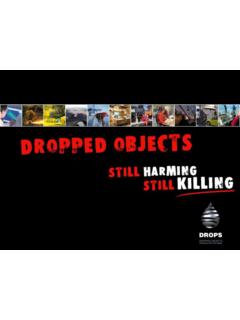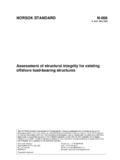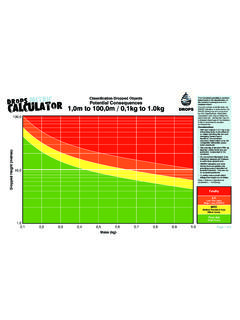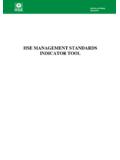Transcription of Dropped Object Prevention Scheme …
1 Dropped Object Prevention Scheme recommended Practice Revision Record Revision Date Comment Issued by: Issue 1 First formal issue DROPS. COVER IMAGE: Courtesy Photographic Services, Shell International Ltd. Dropped Object Prevention Scheme recommended Practice, 2017 2. DROPS Guidance and Best Practice These documents represent Best Practice', as agreed by a consensus of the members of the DROPS. Workgroup. Certain processes and procedures detailed in these documents may require modification to suit specific locations, activities or facilities. However, the underlying guidelines are considered best practice and are a recommended component of any integrated Dropped Object Prevention Scheme . These guidelines are subject to regular review and update in response to improved methodologies and technologies. NOTE: Any industry organisation or body may apply the recommended practices offered by the DROPS initiative throughout their own operations and activities.
2 The recommended practices guidance and elements are available for free download from the DROPS website ( ) and may be copied in part or in full as required and employed in the Prevention of Dropped objects worldwide. These are available copyright free and include editable electronic templates. Where appropriate, credit may be given to the DROPS initiative as the global resource for Dropped Object Prevention guidance. However, under no circumstances shall the DROPS. name, brand or identity be used to promote or endorse any service, product, programme, promotion or publication. Disclaimer The information herein is provided in good faith. Users of the information contained within this publication, neither DROPS nor any of its members past, present or future warrants its accuracy or will, regardless of its or their negligence, assume liability for any foreseeable or unforeseeable use made thereof, which liability is hereby excluded.
3 Consequently, such use is at the recipient's own risk on the basis that any use by the recipient constitutes agreement to the terms of this disclaimer. Dropped Object Prevention Scheme recommended Practice, 2017 3. Table of Contents 1 Introduction .. 6. Background .. 6. Purpose .. 6. Scope .. 6. Definitions .. 7. 10. 2 Dropped Object Prevention Scheme .. 12. Objectives and Targets .. 12. Risk Assessments .. 13. DROPS 14. Hierarchy of 15. Company Roles and Responsibilities .. 16. Safety Management System Bridging .. 17. DROPS Zone Management No-Entry and Restricted Access Zones .. 18. Monitoring and Measurement of Safety Performance .. 20. Training .. 21. 3 DROPS Inspection .. 22. Independent Dropped Objects 22. Systematic DROPS Inspection Program .. 23. Unplanned Inspections .. 25. Installation of Equipment at Height .. 26. Transportation of Equipment and Loads.
4 27. Assurance .. 28. 4 Worksite Dropped Object Hazard Management .. 29. Reliable Securing .. 29. Tubular Handling .. 30. Lifting and Hoisting .. 31. Management of Change .. 32. Portable Tools and Equipment .. 33. Permanent Equipment at 34. Dropped Object Prevention Scheme recommended Practice, 2017 4. Temporary Equipment at Height .. 35. 5 Reporting and Performance .. 36. Minimum Reporting Requirements .. 36. Continuous Improvement .. 37. Self-Assessment .. 38. 6 Other Industry Standards .. 39. Industry Standards and Document Number .. 39. Annex A DROPS Calculator .. 40. Annex B Training Matrix .. 41. Annex C Post Jarring 42. Annex D Tubular Handling 45. Annex E Portable Tools and Equipment .. 47. Figure - Tool Inventory Log .. 47. Figure - Tools At Height Register .. 48. Annex F Installation of Equipment at Height .. 49. Annex G Continuous Improvement.
5 51. Figure A3 CI Template .. 51. Annex H Permanent and Temporary Equipment At Height .. 52. Annex I Transportation and Equipment 54. Annex J Management of 55. Figure Management of Change Sample Form (Part 1 of 3).. 55. Figure Management of Change Sample Form (Part 2 of 3).. 56. Figure Management of Change Sample Form (Part 3 of 3).. 57. Annex K Dropped Object Prevention Scheme Bridging .. 58. Annex L 10 Questions to a Safe Lift .. 59. Annex M Hierarchy of Controls .. 61. Annex N DROPS recommended Practice Gap Analysis .. 62. Dropped Object Prevention Scheme recommended Practice, 2017 5. 1 INTRODUCTION. Background Dropped Objects pose the number one risk of serious injuries, fatalities, and equipment damage in several industries across the globe, but, there is no existing governance for managing the threat posed by Dropped Objects. DROPS is an oil and gas industry-wide initiative focused on preventing Dropped Objects by providing supporting engagement and learning materials as well as setting industry-recognized best practices .
6 Purpose This recommended Practice was developed by a coalition of oil and gas professionals with the aim of setting basic requirements for Dropped Object Prevention that can be incorporated into existing company Safety Management Systems (SMSs). This document sets out minimum recommended practices that support the Prevention of Dropped Objects and the development of policies and procedures for company SMSs. It is not intended to be considered the finalized requirements of a company Dropped Object Prevention Scheme ( Scheme ). Scope The content in this document is intended to be applied to operations in which Dropped Objects could cause harm to people, equipment, and/or the environment. Operations need to be risk-assessed to determine applicability of these guidelines. Exclusions may apply ( , man overboard, tools lost in hole, aircraft operations, well control events).
7 This document focuses on the oil and gas industry, but principles contained within may be applied across industrial bounds. The recommended practices herein set out minimum requirements to be applied within a Dropped Object Prevention Scheme . Additional Guidance sections provide best practice examples in the application of the recommended practices . Dropped Object Prevention Scheme recommended Practice, 2017 6. Definitions Area Owner A singular individual responsible for completion of scheduled DROPS inspections and required maintenance within a specified area per company standards. At Height 6 feet ( meters) above ground level or within 5 horizontal feet of a descent to lower level (handrails). Barrier A function or safeguard planned to prevent, control, or mitigate undesired events or accidents. Barrier Owner An individual responsible for creation or maintenance of a healthy barrier.
8 Bridging Document ( , Interface Agreement). A documented plan that defines how diverse organizations agree on which safety management elements are used when co-operating on a project, contract, or operation. Company The individual, partnership, firm, or corporation that incorporates Dropped Object Prevention into existing safety management systems. Competent Person An individual who is capable of identifying existing and predictable hazards in the surroundings or working conditions and who has the authority to take prompt corrective measures to eliminate them. Contractor The individual, partnership, firm, or corporation that comes to a contractual agreement with an Operator to provide goods and services. DROPS. An industry collaborative organization that supplies supporting material and recommended practices for managing Dropped Object hazards.
9 This may refer to the organization itself or endorsed principles. Dropped Object Prevention Scheme recommended Practice, 2017 7. Dropped Object Prevention Scheme ( Scheme ). A set of principles and methodologies that are put in place as part of a company's safety management system to identify potential Dropped Object hazards, prevent their occurrence, and mitigate their outcome. In this document, the terms Dropped Object Prevention Scheme , Dropped Object Scheme , or Scheme , may be used interchangeably. Dropped Object Any item with the potential to cause injury, death, or equipment/environmental damage, that falls down or over from its previous position. Dropped Objects may be further classified as static or dynamic. Dynamic Dropped Object Any Dropped Object whose failure may be attributed to applied forces ( , from the impact of equipment, machinery, or other moving items, severe weather, or manual handling).
10 High Potential (HiPo) Incident A near miss or other incident that has a strong potential to cause a fatality, life altering injury, major equipment or asset damage, severe environmental harm, or significant operational loss. Incident An unexpected event or chain of events that has resulted in harmful consequences, such as injuries, illnesses, property damage, or environmental impact. Independent Auditors Independent auditors are recognized Subject Matter Experts and build assessments based on a company's Scheme as well as original equipment manufacturer (OEM) recommendations and recognized best practices . Independent auditors have no connections to the company which they are auditing. Jarring The process of dynamically transferring stored energy to free stuck drill pipe. Lagging Indicator Lagging indicators measure the impact of workplace incidents after an incident has occurred.








